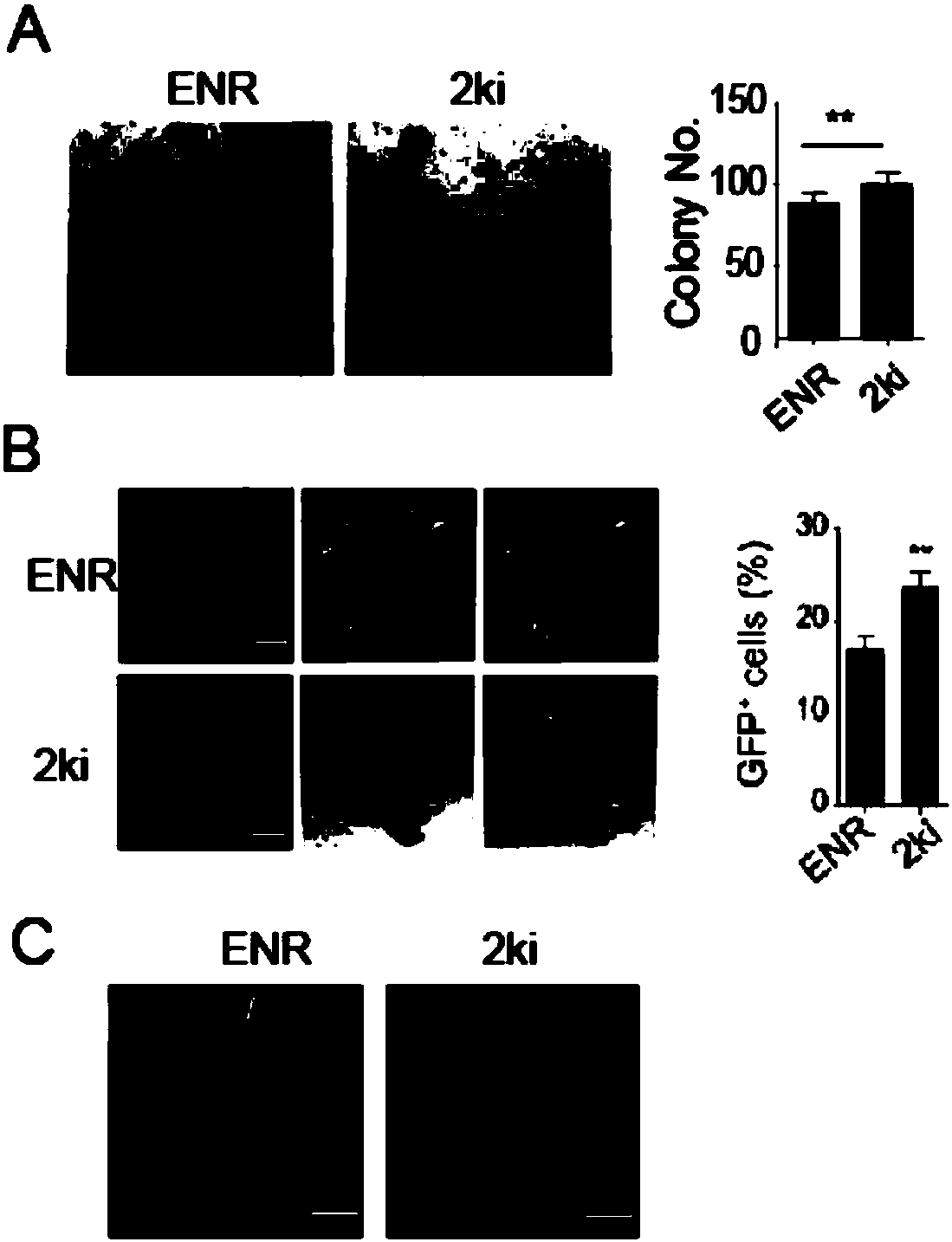Culture medium and application thereof
A medium and basal medium technology, applied in tissue culture, cell culture active agents, microorganisms, etc., can solve the problems of high price and unfavorable promotion of intestinal epithelial stem cell culture system, and achieve the effect of improving the efficiency of in vitro culture
- Summary
- Abstract
- Description
- Claims
- Application Information
AI Technical Summary
Problems solved by technology
Method used
Image
Examples
Embodiment 1
[0039] Example 1 Culture of mouse small intestinal crypts and single stem cells based on 2ki system
[0040] According to the use of the 2ki stem cell medium provided by the present invention in culturing stem cells, the isolated mouse small intestinal lacuna and mouse Lgr5+ small intestinal adult stem cells prepared in this example were cultured. Using small intestinal lacuna and Lgr5+ small intestinal adult stem cells cultured in vitro as small intestinal organoids, the role of the small molecule 2ki in this culture process was explored. According to the method reported in the literature (Sato, T. et al. (2009). "Single Lgr5stem cells build crypt-villus structures invitro without a mesenchymal niche." Nature 459, 262-5), from Lgr5-EGFP-IRES-creERT2 transgenic mice (Can be purchased through The Jackson Laboratory organization, Stock Number: 008875, its feature description: the green fluorescent protein gene GFP is artificially inserted into the downstream of the promoter of t...
Embodiment 2
[0045] Example 2 Long-term culture of mouse small intestinal crypts based on 2ki system
[0046] Using small intestinal lacuna and Lgr5+ small intestinal adult stem cells cultured in vitro as small intestinal organoids, the role of the small molecule 2ki in this culture process was explored. Subsequently, we used this system for long-term culture to confirm that the culture system will not affect the functions and characteristics of small intestinal crypts and stem cells. The specific method is as follows:
[0047] (1) The small intestine was isolated from Lgr5-EGFP-IRES-creERT2 transgenic mice, cut longitudinally and washed three times with pre-cooled PBS buffer with a pH value of 7.4 to remove chyme, and then scraped carefully with a scalpel Remove intestinal villi on the lining of the small intestine. The remainder was cut into 5 mm length intestinal pieces and incubated with PBS buffer containing 10 mM EDTA on ice for 40 minutes. Replace the EDTA-containing PBS buffer s...
Embodiment 3
[0052] Example 3 In vitro culture of mouse colonic crypts based on 2ki system
[0053] According to the use of the 2ki stem cell culture medium provided by the present invention in culturing stem cells, the isolated mouse colon lacuna prepared in this example was cultured. Using the technique of culturing colonic lacunae into small intestinal organoids in vitro, the role of the small molecule 2ki in the culture process was discussed. According to the method reported in the literature (Sato, T. et al. (2011). "Long-term Expansion of Epithelial Organoids From Human Colon, Adenoma, Adenocarcinoma, and Barrett's Epithelium." Gastroenterology 141:1762-1772), from Lgr5-EGFP - IRES-creERT2 transgenic mouse (can be purchased through The Jackson Laboratory, Stock Number: 008875, its characteristic description: the green fluorescent protein gene GFP is artificially inserted into the downstream of the promoter of the endogenous Lgr5 gene, so the transgenic mouse expresses The cells with...
PUM
 Login to View More
Login to View More Abstract
Description
Claims
Application Information
 Login to View More
Login to View More - R&D
- Intellectual Property
- Life Sciences
- Materials
- Tech Scout
- Unparalleled Data Quality
- Higher Quality Content
- 60% Fewer Hallucinations
Browse by: Latest US Patents, China's latest patents, Technical Efficacy Thesaurus, Application Domain, Technology Topic, Popular Technical Reports.
© 2025 PatSnap. All rights reserved.Legal|Privacy policy|Modern Slavery Act Transparency Statement|Sitemap|About US| Contact US: help@patsnap.com



